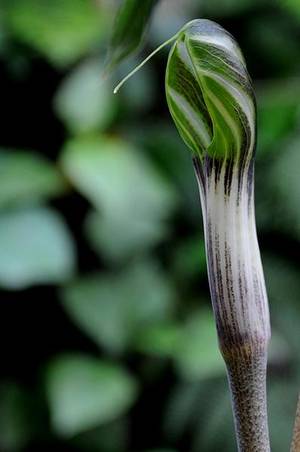Cobra lily: India
This is a collection of articles archived for the excellence of their content. |
2017/ rediscovery after 84 years
Rohan Premkumar, After 84 years, cobra lily rediscovered in Nilgiris, May 23, 2017: The Hindu

Rohan Premkumar, After 84 years, cobra lily rediscovered in Nilgiris, May 23, 2017: The Hindu
Featuring a distinctive translucent spathe, it was last collected by E. Barnes in 1932 and described by C.E.C Fischer in 1933.
The incredibly rare Arisaema translucens, more commonly known as the cobra lily, was rediscovered in the western Nilgiris after 84 years by nature enthusiasts K.M. Prabhu Kumar and Tarun Chhabra.
Featuring a distinctive translucent spathe, it was last collected by E. Barnes in 1932 and described by C.E.C Fischer in 1933.
Barely a few hundred cobra lily plants are left in the wild and they can be found only in a small area measuring less than 10 square kilometres in the Nilgiris.
News of the discovery was published in May 2017 in Phytotaxa, a journal on botanical taxonomy.
“The Toda tribals of the Nilgiris, who know the plant well, have an embroidery motif known as the ‘podwarshk’, which resembles it,” Mr. Chhabra, author of The Toda Landscape, told The Hindu. “If I am not mistaken, this is probably the only member of the Arisaema family to have a translucent spathe, and they are very beautiful.”
Risk of extinction
Mr. Chhabra said that such was the depth of the indigenous community’s knowledge that they could predict the early arrival of monsoon from the blooming of the cobra lily's ‘translucens’. Prized for their beauty around the world, cobra lilies are at even greater risk of extinction from the commercial trade in exotic plants.
Of the handful cobra lily species found in the Nilgiris, only two are endemic, said Mr. Chhabra, who has called for the protection of the patch of land where the Arisaema translucens were found. Likely to have been quite common once, cobra lilies have vanished in the past decades along with the disappearance of the shola tree patches in which they were found. The rediscovery of the plant highlights the importance of preserving whatever is left of shola tree patches, even inside plantations and tea fields.
Dr. Prabhu Kumar, a senior scientist from Kerala and one of the co-authors of the paper, said that based on its tiny population and distribution, the Arisaema translucens could be considered ‘critically endangered’, and concurred that measures must be put in place immediately for their long term survival.